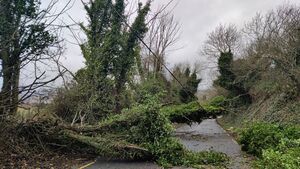Demand for Laois survey after storm topples 90 trees

Storm Darragh brought down about 90 trees throughout Laois. File image
MANY toppled trees that blocked roads in Laois during Storm Darragh were already dangerous and should have been felled well in advance of the storm, a local councillor has claimed.
About 90 trees across the county were ripped down by powerful winds, with gusts of up to 120kph from 6-7 December.
Cllr Ollie Clooney told a council meeting that “the dogs in the street” knew many of these fallen trees had been in dangerous condition. He demanded a countywide dangerous tree survey, to prevent similar havoc in future.
“There could have been 90 accidents if we had bad luck,” the Durrow councillor told the December meeting of Borris-in-Ossory/Mountmellick Municipal District.
He added: “A good few trees fell around our area and they broke walls and fences. If someone was in their way, they could break their heads as well.”
Laois Fire and Rescue Service crews worked around the clock dealing with more than 50 emergency callouts during the storm, due to fallen trees and blocked roads. There were five vehicle-related callouts and one person was brought to hospital following a collision.
Laois County Council’s roads crews also worked throughout the weekend, as a clean-up operation continued in the calm after the storm. According to the council, up to 90 trees fell in locations across the entire county.
While he praised crews for their work during the emergency, cllr Clooney declared that dangerous, overhanging trees should not have been allowed to remain on any road in the first place.
He said: “The ones that fell around us were there for the taking but no one gave a damn. When someone drives dangerously, they are summonsed by gardaí but we still have these dangerous trees overhanging the roads and we do nothing about it. We are going to have more storms with climate change and we are doing absolutely nothing. It beggars belief.
“There were days of clean-up works and wires down and dangerous trees are still left there. The time for talking is over. I want a survey done on dangerous trees, which should be marked. The ones that fell during the storm, the dogs in the street knew they were going to fall.”
Cllr Clooney said it was fortunate that Storm Darragh happened overnight, when few people were out on the roads, as some might “chance their arm” and drive if it was during the day.
He said: “There are dangerous trees overhanging the roads and they'll kill somebody. This has been going on for years and it's a grey area. We have to sort this out, whether it's on the landowner or the council. These trees cannot be allowed to stay on the roads.”
He was supported by cllr John King from Rathdowney, who said there was a particular problem with trees around his local cemetery. He added that landowners also bore a responsibility and the law must be enforced.
The issue arose after cllr James Kelly paid tribute to the fire service and council roads crews for their tireless work during the storm.
Director of services Donal Brennan said the efforts of the fire and council crews that came out during the emergency must be acknowledged. In relation to potentially dangerous trees, he said that council staff did what they could within the law and contacted landowners regarding the need to cut trees that were overhanging roads.
However, Mr Brennan said that a tree fall depended on wind direction and “proactively cutting trees” could lead to too many being cut.
He said: “A tree I had that fell that night was one I wouldn’t have expected to fall. It was because of the wind direction.” Cllr Clooney disagreed, saying that 90% of winds are from the south-west or west, unlike Storm Darragh which brought unusual north-westerly winds.
Cllr Clooney insisted: “If a tree is overhanging the road and there is a south-west wind, they are dangerous trees. I know these trees. They only ever fall one way in 90% of cases, when there are south-west or west winds.”
Mr Brennan told the meeting that he would speak with the senior engineer in the council’s roads division, “to see what we can do to be more proactive towards trees on the roads that may be dangerous”.
Meanwhile, the sterling work of fire service and council crews was also praised at the December meeting of Graiguecullen-Portarlington Municipal District. A total of 34 fallen trees had to be dealt with across the district during the storm, according to senior engineer Philip McVeigh.





